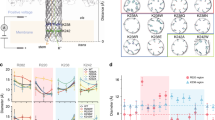Abstract
Nanopores employ the ionic current from the single molecule blockage to identify the structure, conformation, chemical groups and charges of a single molecule. Despite the tremendous development in designing sensitive pore-forming materials, at some extent, the analyte with the single group difference still exhibits similar residual current or duration time. The serious overlap in the statistical results of residual current and duration time brings the difficulties in the nanopore discrimination of each single molecules from the mixture. In this paper, we present the AdaBoost-based machine learning model to identify the multiple analyte with single group difference in the mixed blockages. A set of feature vectors which is obtained from Hidden Markov Model (HMM) is used to train the AdaBoost model. By employing the aerolysin sensing of 5ʹ-AAAA-3ʹ (AA3) and 5ʹ-GAAA-3ʹ (GA3) as the model system, our results show that AdaBoost model increases the identification accuracy from ~ 0.293 to above 0.991. Furthermore, five sets of mixed blockages of AA3 and GA3 further validate the average accuracy of training and validation, which are 0.997 and 0.989, respectively. The proposed methods improve the capacity of wild-type biological nanopore in efficiently identify the single nucleotide difference without designing of protein and optimizing of the experimental condition. Therefore, the AdaBoost-based machine learning approach could promote the nanopore practical application such as genetic and epigenetic detection.




Similar content being viewed by others
References
Deamer DW, Akeson M. Nanopores and nucleic acids: prospects for ultrarapid sequencing. Trends Biotechnol. 2000;18(4):147–51.
Oukhaled A, Bacri L, Pastorizagallego M, Betton JM, Pelta J. Sensing proteins through nanopores: fundamental to applications. ACS Chem Biol. 2012;7(12):1935–49.
Albrecht T, Slabaugh G, Alonso E, Alarif MR. Deep learning for single-molecule science. Nanotechnology. 2017;28(42):423001.
Ying YL, Zhang JJ, Cao R, Long YT. Nanopore-based sequencing and detection of nucleic acids. Angew Chem Int Ed. 2013;5:13154–61.
Gu Z, Ying YL, Long YT. Nanopore sensing system for high-throughput single molecular analysis. Sci China Chem. 2018;61(12):1483–5.
Guo W, Tian Y, Jiang L. Asymmetric ion transport through ion-channel-mimetic solid-state nanopores. Acc Chem Res. 2013;46(12):2834–46.
Asandei A, Rossini AE, Chinappi M, Park Y, Luchian T. Protein nanopore-based discrimination between selected neutral amino acids from polypeptides. Langmuir. 2017;33(50):14451–9.
Sha JJ, Si W, Xu B, Zhang S, Li K, Lin KB, et al. Identification of spherical and non-spherical protein by solid-state nanopore. Anal Chem. 2018;90(23):13826–31.
Plesa C, Ruitenberg JW, Witteveen MJ, Dekker C. Detection of individual proteins bound along DNA using solid-state nanopores. Nano Lett. 2015;15(5):3153–8.
Laszlo AH, Derrington IM, Ross BC, Brinkerhoff H, Adey A, Nova IC, et al. Decoding long nanopore sequencing reads of natural DNA. Nat Biotechnol. 2014;32(8):829–33.
Cao C, Ying YL, Hu ZL, Liao DF, Tian H, Long YT. Discrimination of oligonucleotides of different lengths with a wild-type aerolysin nanopore. Nat Nanotechnol. 2016;11(8):713–8.
Manrao EA, Derrington IM, Laszlo AH, Langford KW, Hopper MK, Gillgren N. Reading DNA at single-nucleotide resolution with a mutant MspA nanopore and phi29 DNA polymerase. Nat Biotechnol. 2012;30(4):349–53.
Soskine M, Biesemans A, Maeyer MD, Maglia G. Tuning the size and properties of ClyA nanopores assisted by directed evolution. J Am Chem Soc. 2013;135(36):13456–63.
Ying YL, Cao C, Hu YX, Long YT. A single biomolecule interface for advancing the sensitivity, selectivity, and accuracy of sensors. Natl Sci Rev. 2018;5(4):450–2.
Wang Y, Tian K, Du X, Shi RC, Gu LQ. Remote activation of a nanopore for high-performance genetic detection using a pH taxis-mimicking mechanism. Anal Chem. 2017;89(24):13039–43.
Bell NAW, Chen K, Ghosal S, Ricci M, Keyser UF. Asymmetric dynamics of DNA entering and exiting a strongly confining nanopore. Nat Commun. 2017;8(1):380.
Bell NA, Muthukumar M, Keyser UF. Translocation frequency of double-stranded DNA through a solid-state nanopore. Phys Rev E. 2016;93(2–1):022401.
Zhang Y, Wu GS, Si W, Ma J, Yuan ZS, Xie X, et al. Ionic current modulation from DNA translocation through nanopores under high ionic strength and concentration gradients. Nanoscale. 2016;9(2):930–9.
Kowalczyk SW, Wells DB, Aksimentiev A, Dekker C. Slowing down DNA translocation through a nanopore in lithium chloride. Nano Lett. 2012;12(2):1038–44.
Banfield RE, Hall LO, Bowyer KW, Kegelmeyer WP. A comparison of decision tree ensemble creation techniques. IEEE Trans Pattern Anal Mach Intell. 2006;29(1):173–80.
Wang YQ, Li MY, Qiu H, Cao C, Wang MB, Wu XY, et al. Identification of essential sensitive regions of the aerolysin nanopore for single oligonucleotide analysis. Anal Chem. 2018;90(13):7790–4.
Hu Z, Li ZY, Ying YL, Zhang J, Cao C, Long YT, et al. Real-time and accurate identification of single oligonucleotide photoisomers via an aerolysin nanopore. Anal Chem. 2018;90(7):4268–72.
Forstater JH, Briggs K, Robertson JWF, Ettedgui J, Marie-Rose O, Vaz C, et al. Mosaic: a modular single molecule analysis interface for decoding multi-state nanopore data. Anal Chem. 2016;88(23):11900–7.
Zhang JH, Liu XL, Hu ZL, Ying YL, Long YT. Intelligent identification of multi-level nanopore signatures for accurate detection of cancer biomarkers. Chem Commun. 2017;53(73):10176–9.
Zhang JH, Liu XL, Ying YL, Gu Z, Meng FN, Long YT. High-bandwidth nanopore data analysis by using a modified hidden Markov model. Nanoscale. 2017;9(10):3458–65.
Freund Y, Schapire RE. Experiments with a new boosting algorithm. In: Proceedings of the 13th conference on machine learning. USA: Morgan Kaufmann; 1996. pp. 148–156.
Acknowledgements
This research was supported by the National Natural Science Foundation of China (6187118, 2183400 and 21711530216), the “Chen Guang” project supported by Shanghai Municipal Education Commission and Shanghai Education Development Foundation (17CG27).
Author information
Authors and Affiliations
Corresponding authors
About this article
Cite this article
Sui, XJ., Li, MY., Ying, YL. et al. Aerolysin Nanopore Identification of Single Nucleotides Using the AdaBoost Model. J. Anal. Test. 3, 134–139 (2019). https://doi.org/10.1007/s41664-019-00088-x
Received:
Accepted:
Published:
Issue Date:
DOI: https://doi.org/10.1007/s41664-019-00088-x




